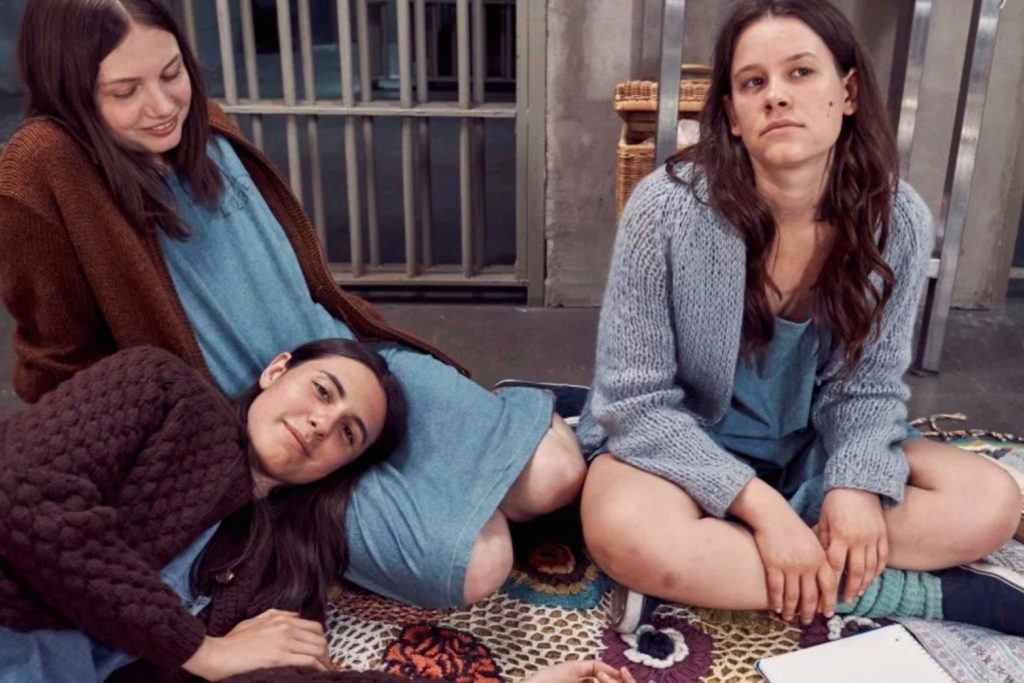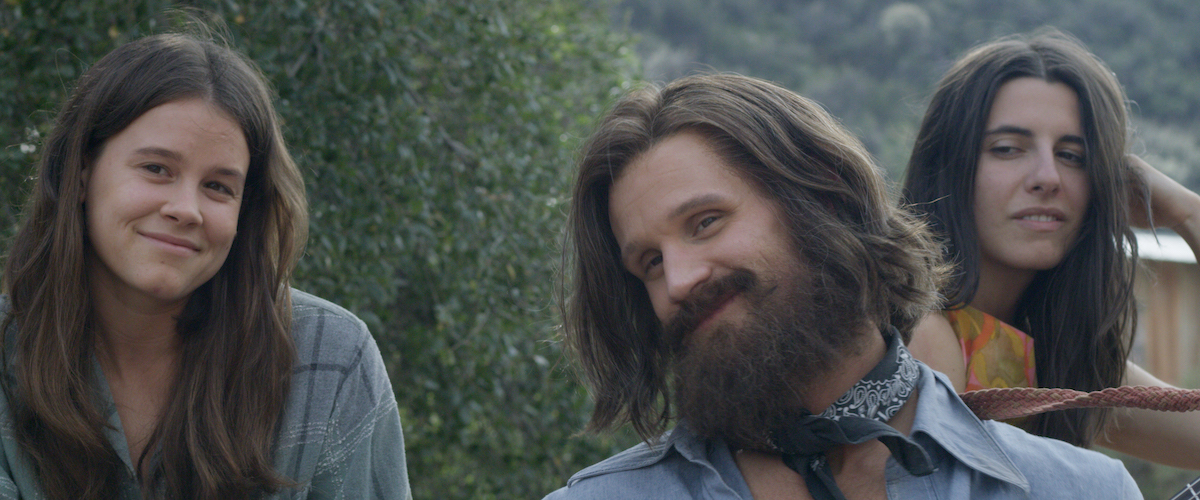In the space of two years, three films about the Manson family murders appeared to varying degrees of critical and commercial success. The universally panned 2019 Hilary Duff vehicle The Haunting of Sharon Tate (written and directed by Daniel Farrands), as well as the more famous, and award-winning film, Quentin Tarantino’s Once Upon A Time… In Hollywood.
The breadth of Tarantino’s project was more than a fantasy re-enactment of what could have happened if that fateful night at the Polanski/Tate home had not occurred. Tarantino’s vision was more concerned with capturing a particular zeitgeist through the events around the murders, but not really the murders themselves. Tarantino also managed to employ some of the best actors working in the industry to create a character driven study of an alternative history of Hollywood. Through Brad Pitt’s Cliff Booth and Leonardo DiCaprio’s Rick Dalton the audience was given a vision of Hollywood in the period that encompassed everything from references to the Natalie Wood murder, through to the emergence of the Spaghetti Western as a way for Hollywood actors to find new parts in a world that was competing heavily with television.
Considering we have reached that juncture again with the emergence of high-quality television being a rival to the cinematic model, Tarantino’s fantasy found a place to land that resonated with audiences and critics alike.
Screenwriter Guinevere Turner and director Mary Harron’s vision is wholly different. Whereas Charles Manson as a character in Once Upon A Time… In Hollywood was so peripheral that actor Damon Herriman as Manson barely had more than a few minutes on screen, Harron places Manson (Matt Smith) front and centre in the narrative.
Ostensibly Charlie Says is about the Manson girls; specifically Leslie ‘Lulu’ van Houten (Hannah Murray), Patricia “Katie’ Krenwinkel (Sosie Bacon), and Susie ‘Sadie’ Atkins (Marianne Rendón), and their journey from their period with Manson on Spahn Ranch, through the Tate-LaBianca murders, and finally to their time in their separate wing of the California Institution for Women where they were kept for years out of general population because their crimes were considered so heinous that they were deemed a risk to other prisoners. There was also immense public pressure on the penitentiary to specifically punish the celebrity murderers. With their death penalties commuted to life without parole, public outcry was at fever pitch because the murders were arguably some of the most notorious in American history. The trial and attendant analysis of the Manson family cult in turn spawned its own cult of followers and aficionados, from the amateur to people like Vincent Bugliosi whose 1974 book Helter Skelter in part forms the basis for most received wisdom on Manson and his followers.
Living in a continuous fantasy loop reinforced by their isolation from the other inmates, the three women are unable to escape the Manson influence until Karlene Faith (Merritt Wever) is brought in to educate, or more precisely re-educate the women, so they may eventually join the general population of the prison. Faith’s task is daunting because after the persistent abuse, gaslighting, enforced drug taking and generalised systematic breaking down of their personalities under Manson — the women have at best, a tenuous relationship with reality. Unravelling the Gordian Knot that Manson placed around their susceptible minds requires constant patience, vigilance, and the ability to gently tease out how truly dangerous and pernicious Manson’s ideas were.

As a premise, Charlie Says works on paper. As a film it’s hampered by what becomes a muddied character study of Manson, who is not served well by Matt Smith’s performance. In effect he comes off as a juvenile, tantrum throwing narcissist — and although that is an aspect of who Manson was, it is an incomplete picture of the man who was able to manipulate a cult of followers into attempting to start a nonsensical race war he termed ‘Helter Skelter’ taken from The White Album by The Beatles. Manson’s fundamental misreading of the album is the stuff of legend and is included in the film. From his ravings on the tracks ‘Revolution’ and ‘Revolution 9’ to his insistence that middle to upper middle-class Californians were ‘piggies’ that needed slaughtering. Also featured are his frustrated attempts to become a famous musician. Manson spent time with drummer Dennis Wilson from The Beach Boys. The song ‘Never Learn Not To Love’ is a rendering of Manson’s ‘Cease to Exist’ and appeared on their album 1969 album 20/20 in later pressings, previously being a B-side to a single. Speculation both inside and outside of the film suggests Manson chose the Tate/Polanski home at 10050 Cileo Drive as the first of the Helter Skelter blitz because the producer Terry Melcher, who refused Manson a recording contract, had previously lived there.
Smith’s portrayal of Manson lacks charisma and magnetism and relies heavily on his threats of violence and ostracism against the Spahn Ranch women, and Family member ad primary Tate-LaBianca murderer Tex Watson (Chace Crawford). Considering how important casting the right Manson for the film would have been, Smith is a curious choice because his performance is hampered by an overly camp quality. A much better version of how the Manson seduction worked was cloaked in Chris Hemsworth’s performance as Billy Lee in Drew Goddard’s 2018 film Bad Times at the El Royale.
To an extent the film feels like a propaganda piece for van Houten, and that is probably due to the source material which draws heavily on Faith’s experiences with the trio. It seems each Manson Family film depends on where the director and screenplay writer are taking their inspiration from. In this case it’s the book The Family by Ed Sanders, poet and founder of The Fugs. Sanders has written on counterculture in California for many years and is also the author of a biography of Tate, as well as numerous other publications. He is also notable for being part of Lawrence Ferlinghetti’s inner circle. Ferlinghetti is a poet of renown and also the co-founder of San Francisco’s legendary bookshop and literary imprint City Lights. Ferlinghetti was famously arrested for publishing fellow poet Allen Ginsberg’s poem Howl. The poem that not only acted as a rallying cry to a series of disaffected intellectuals and thinkers, it was a foundational counter cultural Beat poetry text.
The film is diminished by a series of second-rate visual and narrative scenarios. Both Merritt Weaver and the tremendously talented Hannah Murray do their best to rescue Turner’s disappointingly empty script. Turner has produced some truly groundbreaking work over the years, from the formative film in New Queer Cinema Go Fish to her most famous collaboration with Harron, the extraordinary American Psycho.
Harron, for her part, does an adequate job setting up the dually claustrophobic spaces of Manson’s interiors on Spahn Ranch and the California Institution for Women, but none of it is convincing enough to be more than set pieces. Directorially she is unable to encapsulate the series of events that remain shocking in their ferocity and barbarity.
Ultimately there is no reliable narrator who can tell the story of the Manson family, because everyone involved was compromised in a profound way. Harron attempts to show that was the case for the three women in the Institution, but the scenario is weak and unconvincing. Even as the audience reaches the point of the Cielo drive murders, the horror of it all seems rote and unconvincing. Contrasting these scenes to the visceral madness of American Psycho is an exercise in frustrated potential in how well Harron had previously used violence as cinematic language.
The horror of the Manson murders changed the outlook of a generation in 1969, essentially ending the reign of the new generation of hippie liberation. In history, the other comparable set of murders which changed the outlook of an entire society and ushered in a new mode of thinking were those of Jack the Ripper. A set of murders that although occurring in the late 19th Century prefigured a kind of modernity in the 20th Century. Speculation about the Ripper is an industry unto itself, much like the Manson murders. And like the Manson murders it has appeared numerous times in film and popular culture, again, with varying degrees of success. In both cases the myth of the murders often outweighs the ability of a film to create the gravitas needed to explore them.
Perhaps the object lesson with Charlie Says is that a societal fascination with famous crimes doesn’t always translate to great cinema. Director David Fincher whose Zodiac and the acclaimed television series Mindhunter creates the necessary visual elements of the narratives around notorious crimes and provides a better example of a nuanced approach to true crime.
Pinpointing Harron’s mistakes is an intricate process, and one that far exceeds the limit of a consumer review. Harron and Turner have both created cinematic gems; Charlie Says, isn’t one of them. Audiences will be better served by going through their combined back catalogue for works of greater value.
Director: Mary Harron
Cast: Matt Smith, Merritt Wever, Hannah Murray
Writer: Guinevere Turner, (based on The Family: The Story of Charles Manson’s Dune Buggy Attack Battalion by Ed Sanders, and The Long Prison Journey of Leslie Van Houten


